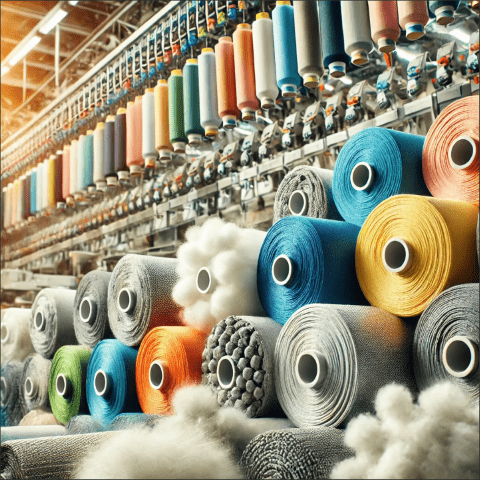Choosing between natural and synthetic fibers impacts comfort, durability, cost, and the environment. Natural fibers come from plants, animals, or minerals, while synthetic fibers are man-made through chemical processes. This guide explores the pros and cons of both, helping you make informed decisions about the textiles you use.
Natural Fibers: Born from Nature
Natural fibers have clothed humanity for thousands of years, each bringing unique properties derived from their organic origins.
Cotton: The Versatile Classic
Cotton remains the world’s most widely used natural fiber, prized for its softness and breathability. This plant-based fiber absorbs moisture effectively, making it ideal for everyday clothing and bedding. Cotton’s durability improves with washing, and it accepts dyes readily, resulting in vibrant, long-lasting colors.
However, cotton production requires significant water resources and often involves pesticide use. The fiber also wrinkles easily and can shrink when exposed to heat.
Wool: Nature’s Insulator
Wool fibers from sheep, alpacas, and other animals provide exceptional insulation properties. The fiber’s natural crimp creates air pockets that trap warmth, making wool garments perfect for cold weather. Wool also naturally resists odors and can absorb up to 30% of its weight in moisture without feeling damp.
The downsides include wool’s tendency to shrink, its potential to cause skin irritation, and its higher cost compared to plant-based alternatives.
Silk: The Luxury Protein Fiber
Silk offers unmatched elegance and comfort. This protein fiber feels smooth against skin, regulates body temperature naturally, and possesses remarkable strength despite its delicate appearance. Silk drapes beautifully and has a natural luster that synthetic alternatives struggle to replicate.
Silk requires careful maintenance, including dry cleaning for many items, and commands premium prices due to labor-intensive production methods.
Linen: The Ancient Favorite
Made from flax plants, linen provides exceptional breathability and becomes softer with each wash. This fiber excels in hot climates, offering natural antibacterial properties and impressive durability when properly cared for.
Linen’s characteristic wrinkled appearance doesn’t appeal to everyone, and the fiber can be stiff when new. Production costs also tend to be higher than cotton.
Synthetic Fibers: Engineered for Performance
Synthetic fibers emerged in the 20th century, designed to overcome limitations of natural materials while introducing new capabilities.
Polyester: The Workhorse
Polyester dominates synthetic fiber production due to its versatility and cost-effectiveness. This petroleum-based fiber resists wrinkles, maintains its shape well, and dries quickly. Polyester blends well with natural fibers, often improving durability while reducing costs.
The main drawbacks include poor breathability, tendency to retain odors, and potential for static buildup. Polyester also contributes to microplastic pollution when washed.
Nylon: Strength and Elasticity
Nylon revolutionized textiles with its exceptional strength and elastic properties. This synthetic fiber resists abrasion, maintains color well, and recovers its shape after stretching. These qualities make nylon ideal for activewear, hosiery, and outdoor gear.
Like polyester, nylon offers limited breathability and can feel clammy during physical activity. The fiber also tends to pill with wear and can be damaged by high heat.
Acrylic: The Wool Alternative
Acrylic fibers mimic wool’s warmth and softness at a fraction of the cost. This synthetic material resists moths, holds colors well, and provides good insulation properties. Acrylic also offers easy care instructions that appeal to busy consumers.
However, acrylic lacks wool’s natural temperature regulation and can feel less luxurious. The fiber also tends to pill more readily than natural alternatives.
Rayon: The Semi-Synthetic Option
Rayon occupies a middle ground between natural and synthetic fibers. Made from processed cellulose, usually from wood pulp, rayon drapes well and accepts dyes beautifully. The fiber breathes better than most synthetics while offering silk-like smoothness.
Rayon’s weakness lies in its care requirements and tendency to lose strength when wet. Some rayon production also raises environmental concerns due to chemical processing methods.
Comparing Natural and Synthetic Fibers
Durability and Longevity
Natural fibers generally age more gracefully, developing character over time. Cotton becomes softer, wool maintains its insulating properties, and linen grows more supple. However, synthetic fibers often provide superior resistance to specific stresses like stretching, chemical exposure, and UV damage.
Cost Considerations
Synthetic fibers typically cost less to produce and purchase, making them attractive for budget-conscious consumers. Natural fibers command higher prices due to agricultural costs, processing requirements, and limited supply chains. However, natural fibers often provide better long-term value through increased longevity.
Environmental Impact
Natural fibers present a complex environmental picture. While biodegradable and renewable, their production can require significant water, land, and sometimes chemical inputs. Synthetic fibers rely on petroleum resources and contribute to microplastic pollution, but they often require less water and land during production.
Applications Across Industries
Fashion and Apparel
Fashion designers choose fibers based on desired aesthetics, comfort, and performance characteristics. Natural fibers dominate luxury markets, while synthetics excel in athletic wear and fast fashion. Many successful garments combine both types, such as cotton-polyester blends that offer comfort with easy care.
Home Textiles
Home furnishing applications favor different fiber types based on specific needs. Natural fibers like cotton and linen excel in bedding applications, while synthetic fibers often provide better stain resistance for upholstery. Flannel fabrics, typically made from cotton or wool, demonstrate how fiber choice affects seasonal comfort.
Industrial Applications
Industrial uses often favor synthetic fibers for their engineered properties. Nylon’s strength makes it ideal for ropes and mechanical applications, while polyester’s chemical resistance suits filtration and protective applications. Natural fibers still find industrial uses where biodegradability or specific aesthetic qualities matter.
Sustainability and the Future
Environmental consciousness increasingly influences fiber choices. Natural fibers offer biodegradability but may require intensive farming practices. Organic cotton, sustainably sourced wool, and peace silk represent efforts to reduce natural fiber environmental impact.
Synthetic fiber manufacturers are developing recycled options, bio-based alternatives, and improved production methods. Recycled polyester from plastic bottles and bio-based nylon from renewable resources show promise for reducing environmental impact.
Innovation continues in both categories. Natural fiber producers are improving farming methods and developing new processing techniques, while synthetic manufacturers are creating biodegradable options and improving recyclability.
Conclusion
Choosing between natural and synthetic fibers depends on your needs and values. Natural fibers offer comfort, breathability, and temperature regulation, while synthetic fibers provide performance, easy care, and affordability. Many textiles combine both to balance their strengths. Understanding these differences helps you select materials that suit your lifestyle.








